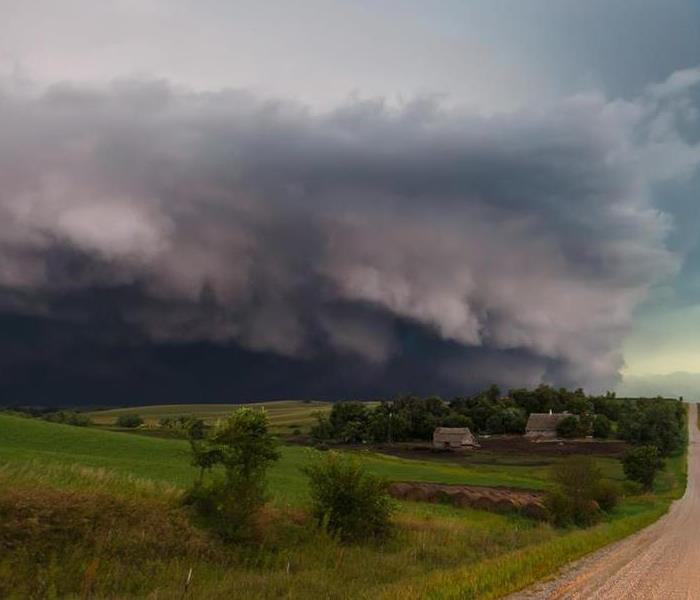Archived Storm Damage Blog Posts
What to throw out and what to save?
2/26/2022 (Permalink)
 Storm damage information
Storm damage information
Flooding in your home, is a downright disaster. Once your family is safe and you’ve checked with your insurance, it’s time to begin content cleaning. This is the first step to returning your home to its previous condition.
Is It Safe to Keep?
Your instinct might be to try to throw away everything that has been submerged in flood waters. However; there are many items you may be able to safely save, clean and restore. Depending on what type of water they were exposed to, items such as drapes, clothing and other material goods might be able to be saved by washing them. This could be in your washing machine or dry cleaning, depending on the type of material. Other items that could be saved and restored include these:
• Rugs
• Furniture
• Toys
• Collectibles
Don’t Risk It; Throw It Away
Certain items should always be thrown away once exposed to flooding. Content cleaning cannot save these, especially if they were exposed to black water. Flood waters will make these unsafe for use or consumption:
• Food or beverages
• Medical supplies
• Clothing or canvas items
• Building supplies such as carpets, pads, drywall, and wood floors
Getting Help Cleaning Up
Start cleanup as soon as it’s safe for you to enter the flooded area. You want to protect yourself with gloves, masks, long pants and sleeves and rubber-soled shoes. The less exposure to contaminated water and items, the better.
When preforming content cleaning after a water backup or residential flooding, don’t go at it alone. Get help from friends, family, or professionals. They’ll be able to help you sort out which items are salvageable, and which are better off sent to the dumpster and replaced with new ones.
Safety during a Storm
2/21/2022 (Permalink)
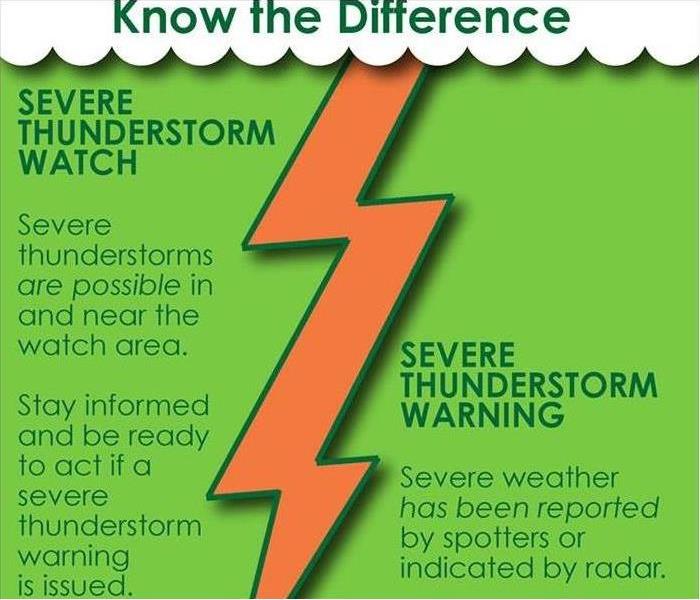 Storm damage information
Storm damage information
Severe weather can happen at any time, anywhere. Each year, Americans cope with an average of the following intense storms:
- 10,000 severe thunderstorms
- 5,000 floods or flash floods
- 1,300 tornadoes
- 2 land falling deadly hurricanes
Knowing your risk of severe weather, taking action, and being an example are just a few steps you can take to be better prepared to save your life and assist in saving the lives of others.
Know Your Risk. The first step to becoming weather-ready is to understand the type of hazardous weather that can affect where you live and work, and how the weather could impact you, your business and your family. Check the weather forecast regularly, obtain NOAA Weather Radio, and learn about Wireless Emergency Alerts. Severe weather comes in many forms, and your shelter plan should include all types of local hazards.
Take Action. Take the next step in severe weather preparedness by creating a communications plan for your home and business. Keep important papers and valuables in a safe place. If you incur any damage during a storm, we can help! SERVPRO of Breckinridge, Grayson, Meade & Hancock Counties. 270-580-2200.
Preparing Our Youth For Disasters and Emergencies
1/19/2022 (Permalink)
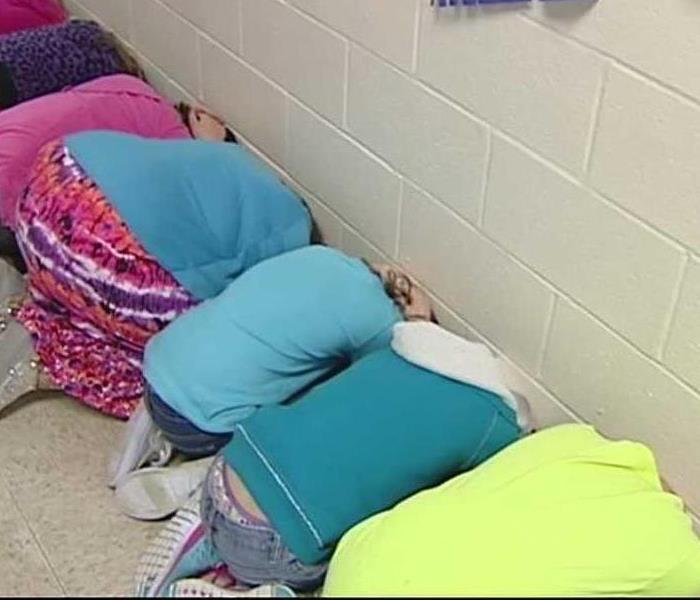 Kids preparing for storms in schools
Kids preparing for storms in schools
When the unexpected happens, will your child know what to do? Disaster can strike anywhere, usually with little to no warning. If your child is put in an emergency situation and doesn't know how to react, they could be severely hurt and may even feel significant anxiety that can follow them for years. With the proper education, though, your child can feel more secure, confident and helpful in the event of a disaster.
Preparing Our Youth
Ultimately, it takes the whole community to educate our youth through preparedness tips and advice. With everyone doing their part, children will understand the seriousness of an emergency situation and strive to become leaders in their classrooms and neighborhoods, ensuring that everybody is prepared for the next disaster. The Federal Emergency Management Agency (FEMA), the American Red Cross and the Department of Education have worked together to create the National Strategy for Youth Preparedness Education a document that outlines a vision for prepared youth in the United States, and how communities can turn that vision into a reality. This document seeks to educate youth and their parents so that communities are better able to prepare for, respond to and recover from future disasters.
How to Prepare Youth for Emergencies and Disasters with Nine Steps
The National Strategy document indicates nine crucial steps that people and organizations at the local, state and federal levels should take to create a strong and prepared youth community. Here's how you can help prepare young people for several types of emergencies and disasters:
- Make it important. Elevating the importance of youth preparedness learning programs in schools and civic organizations allows children to recognize that being prepared is crucial throughout every area of the community.
- Evaluate. If existing youth preparedness programs aren't up to par, develop guidance, tools and up-to-date protective actions in order to ensure that the children in your community are given proper direction.
- Support. Communities, organizations and schools should be able to prepare children without facing unnecessary resistance or interference.
- Create. Establish a relationship between local youth and the first responder community, so that your kids can understand how first responders react in emergency situations. Your kids can also learn from their own heroes what they can do to help in a disaster.
- Link. Connect youth preparedness to family and community participation, so that your child can become an advocate in your area.
- Make school preparedness key. Schools, by their nature, promote broad community participation already, so adding preparedness programs that include curricula, drills and exercises for all local disasters can help children understand what to do when faced with a crisis.
- Build and strengthen. Creating and maintaining partnerships among stakeholder agencies and organizations allows your community to receive up-to-date information about youth preparedness best practices. Local leaders can also be advocates to discuss your community's needs, especially if your area is prone to certain natural disasters.
- Identify. Find opportunities to insert youth preparedness education into youth culture, such as using social media or local ads to initiate a conversation about the importance and effectiveness of preparedness programs.
- Design. Create a sustaining model that designs, develops and delivers valuable programs to train youth in your community. Since certain areas are known to have specific recurring natural disasters, it's important to create a plan that's unique to your community's needs.
By implementing these nine priority steps in your community, your children can receive training to help them feel confident when faced with a disaster. Giving them the tools they need to understand how to prepare for, respond to and recover from several types of emergencies – from fires to floods and more – can make all the difference when disaster actually strikes.
Safety Tips During a Storm
9/8/2021 (Permalink)
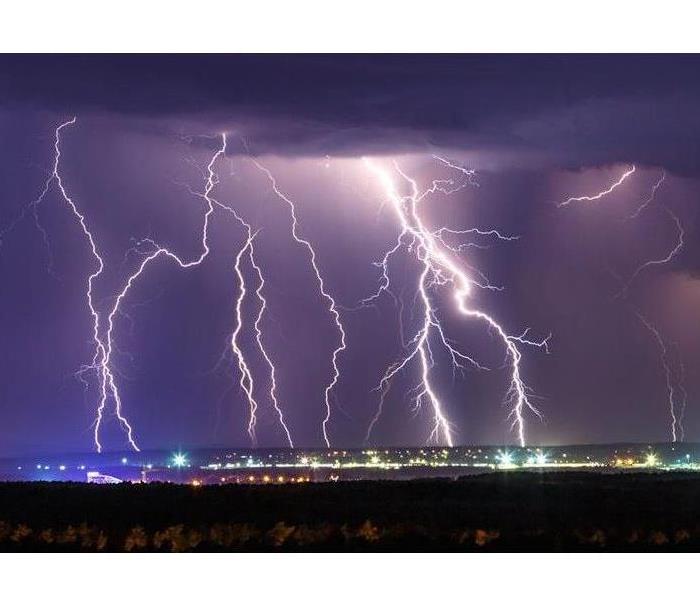 Being prepared for a storm is the best way to stay safe!
Being prepared for a storm is the best way to stay safe!
Lightning from thunderstorms injures hundreds of people in the U.S. every year and kills dozens. These casualties are easily preventable if you follow these simple safety tips.
1. Listen to the radio and television for severe thunderstorm warnings. The National Weather Service issues warnings for counties and even sends out text messages now to our mobile phones when storms are on their way. Pay attention and heed their warnings for safety.
2. Remember the 30 second rule. If there is not 30 seconds in between the time you see lightning and hear thunder, it’s time to go indoors.
3. Lightning typically strikes the tallest object around so if there is a storm, move indoors if at all possible or into a hard top car if there are no buildings around.
4. Once inside, stay away from windows, plumbing and electrical. If lightning strikes outside, it can carry inside via land lines.
5. Get out of boats and away from bodies of water. If you can hear thunder than you are close enough to get struck by lightning.
6. If you are caught outside, avoid standing by tall isolated objects such as trees. Find a grouping of small trees surrounded by taller ones, avoid bodies of water, and if there is only open spaces, look for a dry low-lying area and try to make yourself the smallest target possible. Do not lay flat on the ground, rather crouch with your head between your knees. Sheds, outhouses and tents provide no safety so keep this in mind when you are hiking or camping. Always think ahead and be prepared in the event that you are caught in a thunderstorm and if possible, turn around on your trip and head home.
How Do I Know if I Need Flood Restoration After a Storm Hits Kentucky?
9/1/2021 (Permalink)
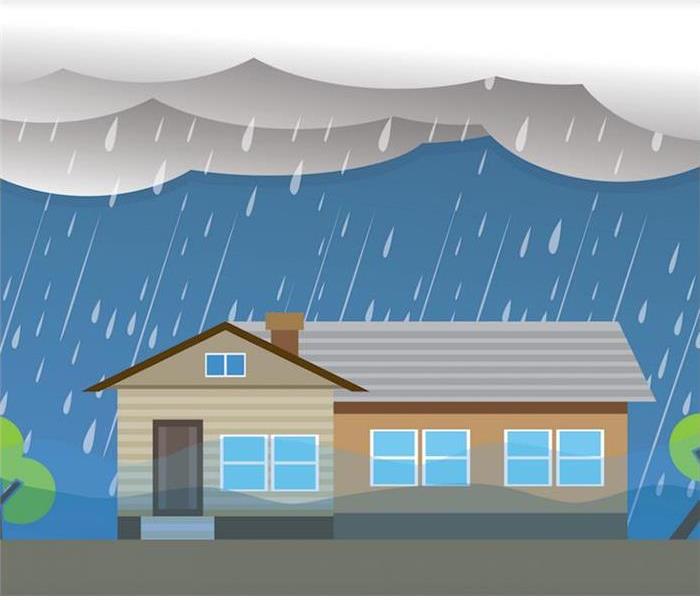 When a storm causes flooding in your home, calling the certified technicians at SERVPRO is your best recourse. We are standing by 24/7.
When a storm causes flooding in your home, calling the certified technicians at SERVPRO is your best recourse. We are standing by 24/7.
SERVPRO is Available 24/7 for Water Damage Restoration in Our Territory
Anyone who lives in Kentucky knows that thunderstorms can come in fast and furious in the summer. It could be nice and sunny for most of the day, and then suddenly, a fierce storm can strike your neighborhood. Rainstorms often bring with them high-speed winds and sometimes even hail or grapple. This combination of negative weather occurrences could create a situation where your structure gets breached.
During flood damage restoration, our SERVPRO technicians often find that a branch or a rock that blew from the wind gets thrown into your house and breaks a window or part of your roof. Once the inside of your structure gets exposed to the elements, more issues could take place. For example, if it is still raining heavily after one of your windows breaks, moisture can leak in from the hole and damage your building materials and contents.
If items inside your house ever get wet after a storm, our SERVPRO can help you by providing the following services:
- Emergency Services after Water Damage
- Leaking Roof from Storms
- Ceiling Repairs from Water Damages
- Flood Restoration
- Water Removal Services
- Water Clean Up
Since rainwater comes from the outdoors, there is a chance it is contaminated, so we classify it as a category two water damage, and we take extra steps to get rid of contaminants. If any of your carpets or other porous materials got wet, we can remove them and then spray antibacterial disinfectants on your non-porous building materials like floorboards and wall studs.
If water ever comes into your house after a branch shatters one of your windows, call SERVPRO of Breckinridge, Grayson, Meade and Hancock Counties.
After Storm Tips
9/1/2021 (Permalink)
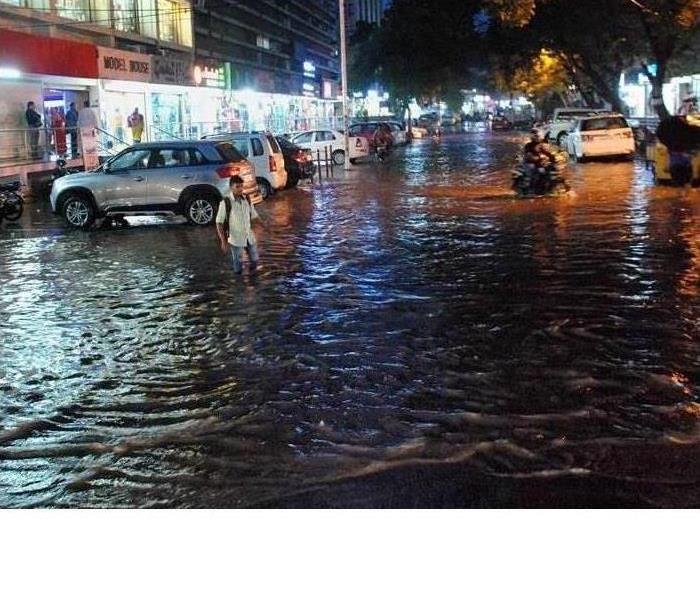 Call us at 270-580-2200 if you experience flooding.
Call us at 270-580-2200 if you experience flooding.
Here are some tips in case you encounter flooding or flash flooding.
- Photograph The Damage. You can never take too many photos. Your insurance company will thank you and you will have a much easier time with your claim if you have good photos.
- Contact Your Insurance Provider. As soon as you have gathered preliminary information, you should contact your home insurance provider. In the event that your vehicle has suffered damage, contact your auto insurance provider.
- Safety First. Be mindful of fallen power lines and take care not to come in contact with electrically charged water.
- Inspect Plumbing. Turn of your water main if necessary. Contact a trusted plumbing contractor if you discover plumbing damage.
- Disconnect electrical appliances that have come in contact with water. Turn off main power at the power source. Contact a electrician if you discover damaged electrical wires.
- Inspect your roof. Heavy rains and wind may have dislodged some of your roofing. If you discover any damage, contact a roofing contractor.
- Contact SERVPRO of NW Portland. If the storm has resulted in flooding, call SERVPRO of Breckinridge, Grayson, Meade and Hancock Counties immediately to start the water remediation process. Secondary water damage can occur in as little as 24 hours.
- DO NOT attempt to remove fallen trees yourself. Contact a reputable arborist if the tree is on your property or the appropriate municipality if it has fallen across public lands or roads.
- Always work with trustworthy local service providers. Unfortunately, there are some companies that attempt to take advantage of storm events. Always obtain a written contract that outlines the service expectations and a breakdown of costs.
SERVPRO of Breckinridge, Grayson, Meade and Hancock Counties specializes in the cleanup and restoration of residential and commercial property after a storm event. Our staff is highly trained in property damage restoration. From initial and ongoing training at SERVPRO’s corporate training facility to regular IICRC-industry certification, rest assured our staff is equipped with the knowledge to restore your property. If storm damage strikes your home, trust the damage restoration industry leader. 270-580-2200
Tips on Keeping Pipes from Freezing
12/9/2020 (Permalink)
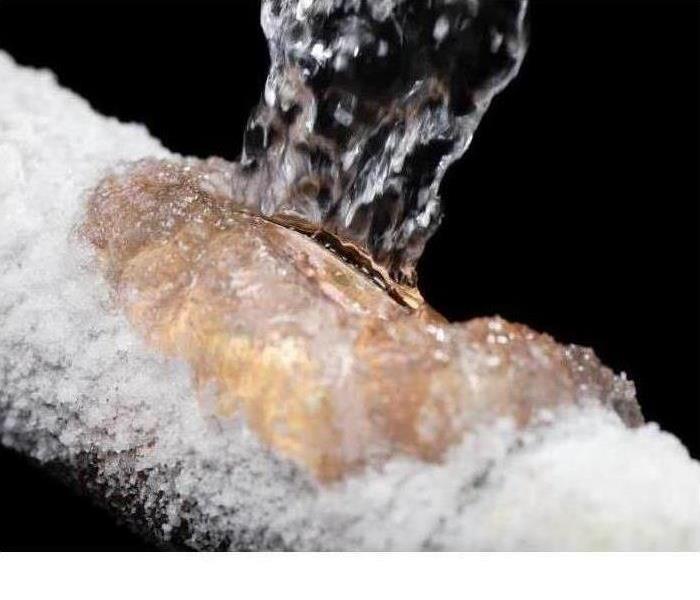 A pipe break that is leaking water.
A pipe break that is leaking water.
With winter right around the corner, there is always a risk of frozen pipes. With some seasonal preparation, you can significantly reduce your risk of plumbing breaks, and the water damage it can cause. Here are a few tips on how to do that.
Keep garage doors closed if there are water supply lines in the garage.
In extreme cold conditions, open kitchen and bathroom cabinets to expose the pipes to warmer air. Make sure any harmful cleaners or household chemicals are out of reach for pets and children.
During freezing temperatures, allow a small amount of water to drizzle from the faucet. This continuous movement of water through the pipes helps keep them from freezing.
Keep the thermostat at the same temperature at night and during the day. During freezing temperatures, you want to keep the temperature at least 70 degrees.
If you’re going to be gone during the cold weather, you’ll want to leave the thermostat to at least 55 degrees.
If you happen to experience a water damage because of a frozen pipe this winter season, know that SERVPRO of Breckinridge, Grayson, Meade and Hancock Counties is here to help.
Tips on Driving in the Rain
8/17/2020 (Permalink)
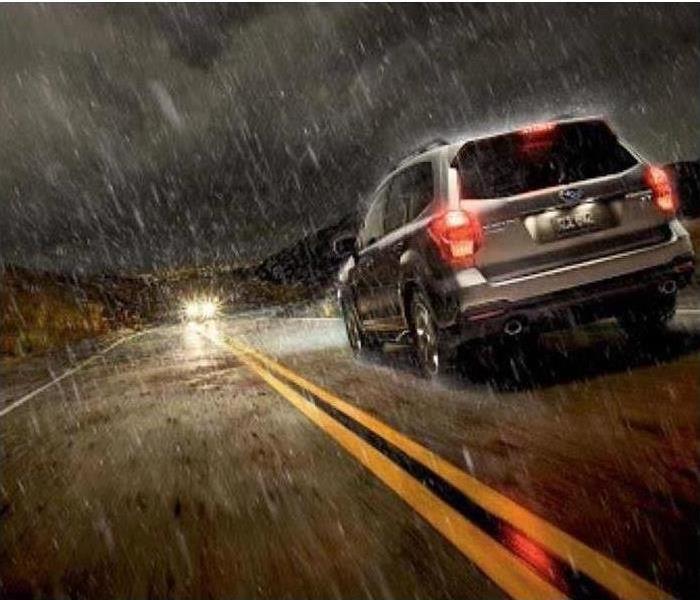 SERVPRO
SERVPRO
Did you know nearly half (47%) of all weather-related car accidents — more than 700,000 a year — are due to rain? Read below for our tips on how to drive safely in the rain.
Here are 10 tips for driving in the rain:
Step 1. Exercise caution. Engine oil and grease build-up on roads and highways over time, and when combined with precipitation, you’ve got the equivalent of an automotive Slip ‘N Slide.
Step 2. Slow down. Wet pavement causes tires to lose traction and vehicles become more difficult to handle.
Step 3. Use headlights. Always use headlights in the rain – even if it’s just a sprinkle. Headlights help you see and be seen in wet weather.
Step 4. Keep your windshield wipers in tip-top shape. Summer can wreak havoc on your blades, so get them checked before fall’s showers arrive.
Step 5. Defog your windows. Precipitation can cause your windshield to quickly fog up, so use the front and rear defrosters to maximize visibility.
Step 6. Avoid pooling water. By splashing through puddles you can impair your vision and other drivers’. Additionally, standing water often shields potholes and debris from view and it can reduce the effectiveness of your vehicle’s brakes.
Step 7. If your car begins to hydroplane, do not brake or turn the wheel abruptly as this may cause your vehicle to go into a skid or spin. Take your foot off the gas and keep the wheel straight until your car reclaims traction.
Step 8. Increase your following distance. Slick roads, wet brakes and reduced visibility can lead to collisions. Give other vehicles plenty of room and brake early with reduced force.
Step 9. Don’t use cruise control. It can cause your car to accelerate when hydroplaning and reduces driver attentiveness.
Step 10. Drive in the tracks of the car in front of you. This allows the vehicle ahead to displace any standing water that’s on the road.
By employing these safe driving techniques you can keep yourself and your passengers safe during spring drizzles and downpours. Rainy roads can be dangerous, but if we all slow down and use extra caution, rainy days might actually be a little brighter.
Faster To Any Size Disaster
8/17/2020 (Permalink)
 SERVPRO
SERVPRO
Storms and inclement weather can be devastating to any business. Wind damage, heavy rain, and flooding can occur suddenly and cause substantial damage in a matter of minutes. There is never a convenient time for flooding or storm damage to strike your business. Every hour spent cleaning up is an hour of lost revenue and productivity. SERVPRO of Romulus provides emergency cleaning and restoration services 24 hours a day, 7 days a week—including all holidays. You can expect an immediate response time, day, or night.
Why Choose SERVPRO of Romulus?
- We are Faster to Any Size Disaster: Floods and storms do not wait for normal business hours, and neither do we. You can depend on an immediate response from our highly trained technicians, who are available 24 hours, seven days a week.
- We're Highly Trained Storm Damage Specialists: As leaders in the storm and water damage industry, we have advanced training and expertise, not to mention a tremendous amount of hands-on experience. We use this training and experience to quickly dry your home and restore it back to pre-storm condition.
- Water Damage Restoration Technician
- Applied Structural Drying Technicians
- We Have the Resources to Handle Storms and Disasters: In addition to our own resources, we can access equipment and personnel from over 1,800 Franchises across the state and country. We can even call upon strategically located Disaster Recovery Teams for catastrophic storms and major events.
Our Disaster Recovery Team
Disaster Recovery Team can provide help whether you're dealing with a tornado, hurricane, blizzard or flood. The SERVPRO System has a network of strategically positioned storm teams on standby should a disaster strike near you. Available 24 hours a day and 365 days a year, we are prepared for the unpredictable.
With the ability to mobilize local command centers, along with the resources of more than 1,800 Franchises nationwide, no disaster is too big. Recent mobilizations of the Catastrophic Storm Response Teams include:
- 2020 Midland Floods
- 2019 Hurricane Dorian
- 2018 Hurricane Florence
- 2018 Hurricane Michael
- 2017 California wildfires
- 2017 Hurricane Irma
- 2017 Hurricane Harvey
- 2016 Hurricane Matthew
- 2015 Carolina floods
- 2014 Polar Vortex
- 2012 Sandy
- 2010 Nashville floods
- 2008 Ike
- 2007 Chicago floods
- 2007 Ohio floods
- 2007 California wildfires
- 2005 Katrina/Wilma/Rita
Should a storm or major event strike, we will make it “Like it never even happened.” Call (270)580-2200, we are always here to help!
Preparing for a Storm or Flood
8/14/2020 (Permalink)
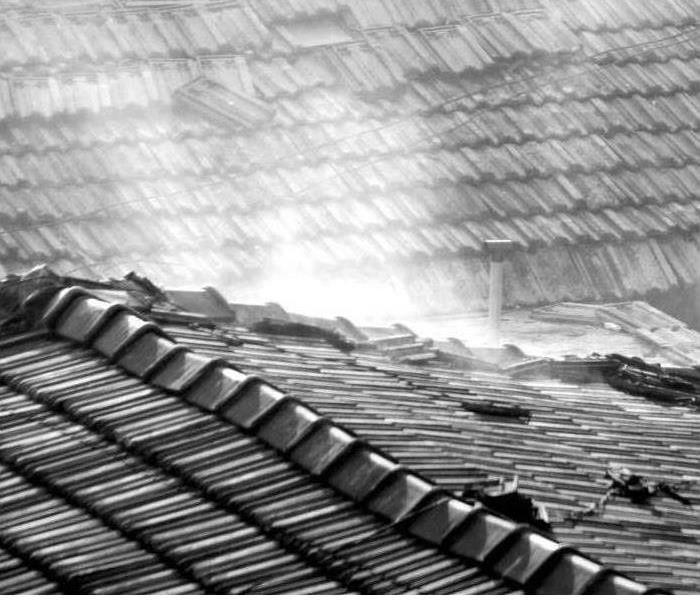 Storms, floods, or any kinds of damage. Your local SERVPRO is here to help.
Storms, floods, or any kinds of damage. Your local SERVPRO is here to help.
Sometimes a storm can bring some serious water damage, even a flood. Are you prepared for a flood? Most people aren’t, so here are a few tips to be storm and flood ready!
- Water (A 3+ day supply; one gallon per person per day.)
- Food (3+ day supply of non-perishable, easy-to-prepare food.)
- Flashlight
- Battery-powered or hand-crank radio (NOAA Weather Radio, if possible)
- Extra batteries
- First Aid Kit
- Medications (7 – day supply) and medical items (hearing aids with extra batteries, glasses, contact lenses, syringes, cane)
- Multi-purpose tool
- Sanitation/personal hygiene items
- Copies of personal documents
- Cell phone with chargers
- Family and emergency contact info
- Extra Cash
- Emergency blanket
- Map(s) of the area
- Baby supplies (bottles, formula, baby food, diapers)
- Pet supplies
- Tools/supplies for securing your home
- Extra set of car keys and house keys
- Extra clothing, hat and sturdy shoes
- Rain gear
- Insect repellent and sunscreen
- Camera for photos of any damage
Staying in Business After a Storm
8/14/2020 (Permalink)
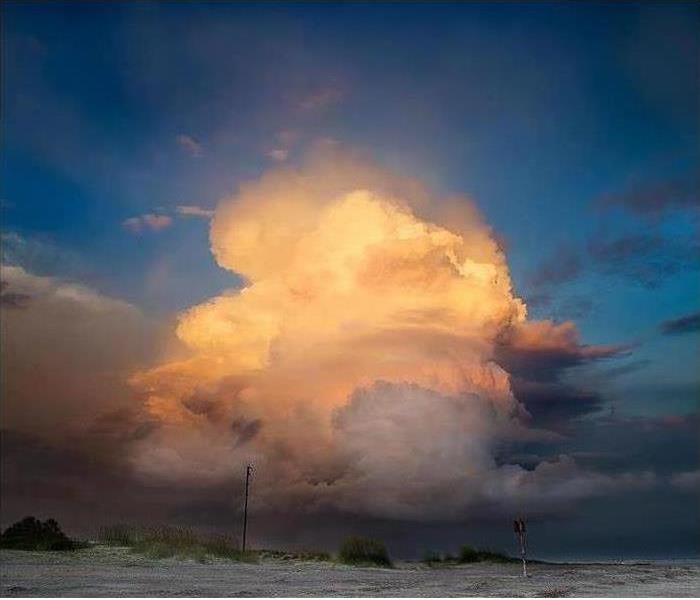 SERVPRO
SERVPRO
As a business owner or manager, you are a leader in your community, and have the opportunity to set an example for your employees, customers, and community to follow.
This year, join your community in preparing for emergencies and disasters of all types, and leading efforts to encourage the community as a whole to become more prepared.
Disasters not only devastate individuals and neighborhoods, but entire communities, including businesses of all sizes. As an employer in your community, having a business continuity plan can help protect your company, its employees, and its infrastructure, and maximizes your chances of recovery after an emergency or disaster.
Ready Business asks companies to take three simple steps: - Plan to stay in business - Encourage your employees to become ready - Protect your investment
Ready Business, an extension of the Ready Campagin, helps business owners and managers of small and medium-sized businesses to prepare their employeees, operations, and assets in the event of an emergency. At ready.gov/business, companies can find vital information on how to get started preparing their organization and addressing their unique needs during an emergency.
Learn About the ERP
8/14/2020 (Permalink)
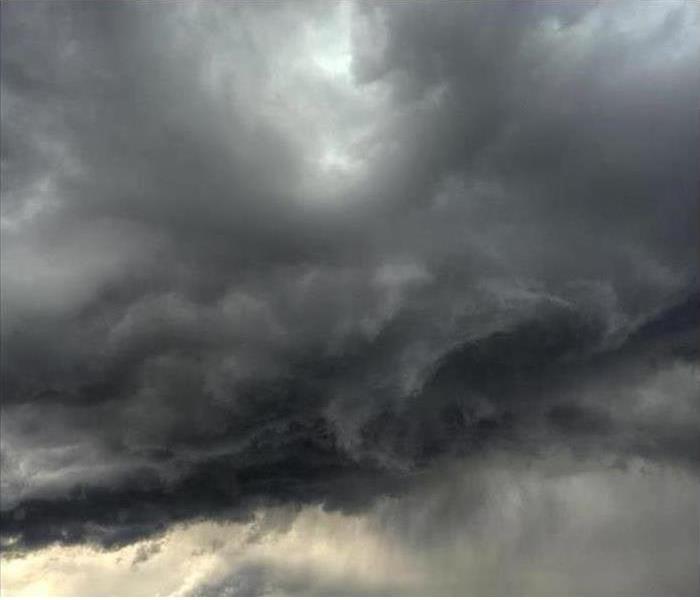 SERVPRO
SERVPRO
No matter where you live, it is important to be informed and prepared for any natural disaster that may occur. Natural disasters often strike without warning, leaving behind a trail of destruction and devastation. Though Mother Nature's disasters are often unpredictable, there are steps you can take to ensure you are prepared.
Contact SERVPRO of Breckinridge, Grayson, Meade and Hancock Counties to establish an Emergency READY Profile (ERP) for your property. SERVPRO's ERP serves as a quick reference document, detailing important building and contact information for your property in the event of an emergency. The ERP is an ideal supplement to any existing preparedness plan, or may be used as a standalone document. Knowing what to do and who to call in advance is the key to timely mitigation, and can minimize the effects of any weather-related disaster, water, or fire damage to your business.
When disaster strikes, make sure you have experienced professionals on the line. No matter how big or small, SERVPRO of Breckinridge, Grayson, Meade and Hancock Counties will be ready to help make your property damage "Like it never even happened."
Being prepared for a Storm and Flood.
11/14/2019 (Permalink)
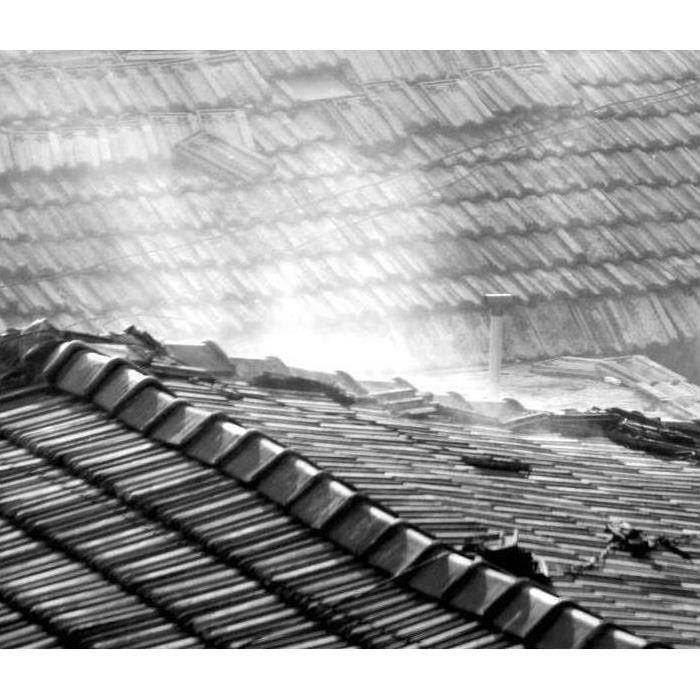 SERVPRO Of Breckinridge, Grayson, Meade and Hancock Counties
270-580-2000
SERVPRO Of Breckinridge, Grayson, Meade and Hancock Counties
270-580-2000
Sometimes a storm can bring some serious water damage, even a flood. Are you prepared for a flood? Most people aren’t, so here are a few tips to be storm and flood ready!
- Water (A 3+ day supply; one gallon per person per day.)
- Food (3+ day supply of non-perishable, easy-to-prepare food.)
- Flashlight
- Battery-powered or hand-crank radio (NOAA Weather Radio, if possible)
- Extra batteries
- First Aid Kit
- Medications (7 – day supply) and medical items (hearing aids with extra batteries, glasses, contact lenses, syringes, cane)
- Multi-purpose tool
- Sanitation/personal hygiene items
- Copies of personal documents
- Cell phone with chargers
- Family and emergency contact info
- Extra Cash
- Emergency blanket
- Map(s) of the area
- Baby supplies (bottles, formula, baby food, diapers)
- Pet supplies
- Tools/supplies for securing your home
- Extra set of car keys and house keys
- Extra clothing, hat and sturdy shoes
- Rain gear
- Insect repellent and sunscreen
- Camera for photos of any damage
Storms Can Cause Flooding and Water Damage in your home.
7/10/2019 (Permalink)
 When your basement or main living space is under many inches of water, contact SERVPRO to dry out the property and help prevent mold
When your basement or main living space is under many inches of water, contact SERVPRO to dry out the property and help prevent mold
Storms Can Cause Flooding and Water Damage in your home.
A storm sweeping in can bring a storm with intense wind and rain that can cause water damage to your home. You may think nothing much of a storm staring when you are on your way to work, but if you have left your basement window ajar, it can be a problem for your home. By the time you get home, your downstairs entertainment room has been flooded, and your furniture has been soaking up water for hours. The situation can seem like a disaster at first glance, but there is help close by that can lend a hand.
The longer that your home sits with the water damage in Kentucky accumulating, the more of a problem it can become for you. Your hardwood floors can blister and swell from absorbing the water, your furniture can soak up the water and become the perfect place for mold growth, and your electronics can malfunction. The sooner that you call for help, the more likely a successful remediation can occur.
When we arrive, SERVPRO can immediately focus on getting the excess water out of your home. We can use tools like wet/dry vacuums and portable pumps to remove the flooded water from your property. After, we can use extractors to pull water from your furniture and curtains. Once the excess water has been removed from your home, SERVPRO can focus on any belongings that are in urgent need of remediation.
We can send your electronics to a repair facility to try and draw any water out of them. Any boxes that had valuables packed in them can be emptied, dried, and repacked in new boxes. Once we are finished, we can set up tools like ventilation fans and dehumidifiers to help dry the structure of your home.
If a storm hits your home and causes water damage, do not pause and consider what you should do. Reach out and contact SERVPRO of Breckinridge, Grayson, Meade & Hancock Counties at 270-580-2200. Day or night, we make it our priority to get to your home as swiftly as possible.
Does Homeowners Insurance Cover Storm Damage?
7/10/2019 (Permalink)
Homeowners insurance may help cover certain causes of storm damage, including wind, hail and lightning. However, damage caused by flood and earthquakes typically is not covered by a standard homeowner’s insurance policy. It's important to read your policy to learn what types of storm damage may or may not be covered.
WHAT TYPES OF STORM DAMAGE DOES HOMEOWNERS INSURANCE COVER?
Homeowners insurance typically helps cover the following types of storm damage:
- Water and Ice Damage
- Lightning Strikes and Power Surges
- Wind, Hail and Fallen Trees
Water and Ice Damage
Whether it's a thunderstorm in the spring or a roof covered in ice, water can damage a home. While ice and hail damage are typically covered by homeowner’s insurance — up to the limits stated in your policy — coverage for water damage varies, depending on the cause. For example, you may find homeowners insurance helps protect you if a frozen pipe bursts in your home. Review your policy to learn what types of water damage it covers.
Lightning Strikes and Power Surges
Should lightning strike your home or other structure covered by your policy, the resulting damage, such as fire or smoke damage, is typically covered by homeowners insurance. Some policies also provide coverage for power surges and outages that are the result of a lightning strike, such as damaged electronics or appliances. As with any coverage, limits will apply. Check your policy or contact your agent to learn the types and amount of coverage it provides.
Wind, Hail and Fallen Trees
If a strong storm roars through, you may find your siding damaged by hail and shingles that the wind ripped off the roof. Homeowners insurance typically covers wind damage. Coverage also usually includes damage from hail, wind-driven rain or snow that gets inside the home when a roof or wall is damaged due to wind. Most policies also offer some coverage for fallen trees that damage your home, provided the tree broke because of a storm or wind.
A Guide for Sump Pump Maintenance
6/21/2019 (Permalink)
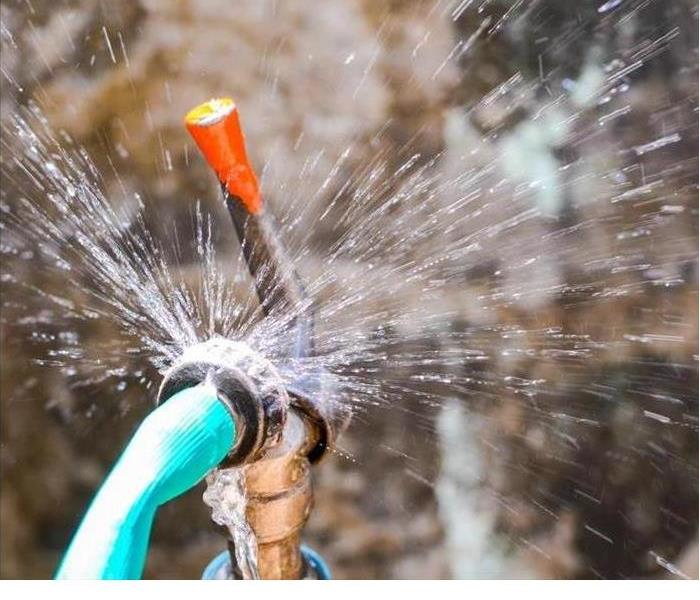 SERVPRO of Breckinridge, Grayson, Meade & Hancock Counties
SERVPRO of Breckinridge, Grayson, Meade & Hancock Counties
When you live in Kentucky you may find that owning and maintaining a sump pump on your property is a good step for mitigating potential water damage. However, simply installing a pump isn’t always enough.
Proper pump maintenance can also be important when it comes to protecting your home from water damage.
What Is a Sump Pump
The standard use of a sump pump is to keep water from accumulating in or around your home in order to help prevent costly damage that may arise from standing water. In most cases these devices are used in homes built in areas that experience frequent storms, wet climates, or frequent accumulation of water in areas such as a basement.
Some Steps for Maintenance
If you have or are considering installing a pump to combat accumulating water, it’s important to perform regular maintenance. Some steps you may want to take include:
- Inspecting your pump for clogged screens or debris in the intake
- Inspecting the discharge pipe for clogs, gravel, mud or other debris that can affect operation
- Using a GFCI plug outlet for your machine
- Inspecting the cord for wear and tear that could create problems
- When in Doubt Ask for Help
If you feel your pump isn’t working properly, or that you may have too much water for it to handle, it may be time to call a professional for help. They may be able to tell you if there’s something wrong with your pump as well as help identify any issues that may be leading to the excess water. In the event of damage to your property you may want to speak with a water damage professional as well.
When it comes to protecting your home from water damage in Kentucky proper pump maintenance is just as important as having a sump pump installed. Keeping your pump maintained can help ensure it’s in operation when you need it. Remember, if you think there’s a problem with your pump or have more water than normal, it may be time to call a professional.
How To Prepare Your Business for a Flood
6/15/2019 (Permalink)
 SERVPRO of Breckinridge, Grayson, Meade & Hancock Counties
SERVPRO of Breckinridge, Grayson, Meade & Hancock Counties
Flooding can occur with little warning, and if you haven’t prepared, it could be time-consuming to restore your business in Kentucky. Knowing how to prepare your business for a flood can make you feel more confident about handling a disaster of any kind.
1. Backup Important Documents
After a flood, it’s often necessary to access certain documents, and not being able to quickly and easily access what you need when you need can slow down the restoration process. In addition to storing your documents in a water-resistant container that is high off the ground, having extra copies of your documents can also be helpful. Many business owners choose to make electronic copies and paper copies to ensure that important information is not lost.
2. Check Your Insurance Policy
Restoration is often necessary after flooding but having to put a project on hold because of the cost can be a major setback. It can be useful to review your insurance policy and find out what costs your policy will cover prior to a flood. Additionally, knowing what resources are available to business owners in your area after a disaster can give you a better idea of what costs you might be responsible for as the owner of your business.
3. Contact a Mitigation and Restoration Company Before Damage Occurs
If you know that your area is likely to sustain any type of damage from a flood, especially if severe damage such as black water damage is likely, it can be useful to contact flood damage restoration experts before your property is affected. After a disaster, you may feel as if you don’t have the time to research a company. However, by contacting professionals before a flood, you can ask questions without feeling stressed or rushed.
By preparing for flooding, you can help to protect your business from major damage. As you prepare, it can be helpful to backup documents, review your insurance policy and contact a restoration company prior to a flood.
Call Our Experts Right Away After A Flood Causes Damage To Your Home
5/28/2019 (Permalink)
 SERVPRO of Breckinridge, Grayson, Meade & Hancock Counties
SERVPRO of Breckinridge, Grayson, Meade & Hancock Counties
As a homeowner, you never think that it could happen to you, but suddenly torrential rains fall all around you, and your home is in the path of the water. Being prepared for the onset of disaster is the most crucial step you can take towards protecting your home. Aside from the necessary supplies and precautions recommended by local community helpers, you should also identify the best professional team to help you restore your home in case there is water damage as a result of the weather.
When a flood causes damage to your home SERVPRO is the right team for you to call. Our rapid response hotline is available 24/7 and is quick to respond to your emergency. Our Green Fleet is fully equipped with the latest equipment and technology to rapidly extract water from your home and mitigate the loss of time and money following a disaster.
One of the primary concerns, when there is flood damage, is the presence of bacteria in your home as the result of water coming from the outside, otherwise known as black water. Unwanted debris and organisms can enter your house and need to be removed as soon as possible. Our truck-mounted pumps are ideal to extract a large volume of water and dispose of it by relevant regulations. For smaller water accumulations our SERVPRO team can use handheld instruments that allow us to access hard to reach corners of your home.
Unfortunately, one of the by-products of flood damage is the removal of porous surfaces such as carpets and upholstered materials. Because of the hazard flood water poses, our SERVPRO team disposes of these items quickly and according to environmental recommendations. Our field experience lets us understand the intricacies of this process and make it simple for you as the homeowner.
Having your home be in the middle of the flood is overwhelming. SERVPRO of Breckinridge, Grayson, Meade & Hancock Counties is here to help. We can be reached at 270-580-2200 when disaster strikes so our competent team can join you in restoring your property to pre-damage condition.
Why Waiting For an Adjuster Has Risks
11/13/2018 (Permalink)
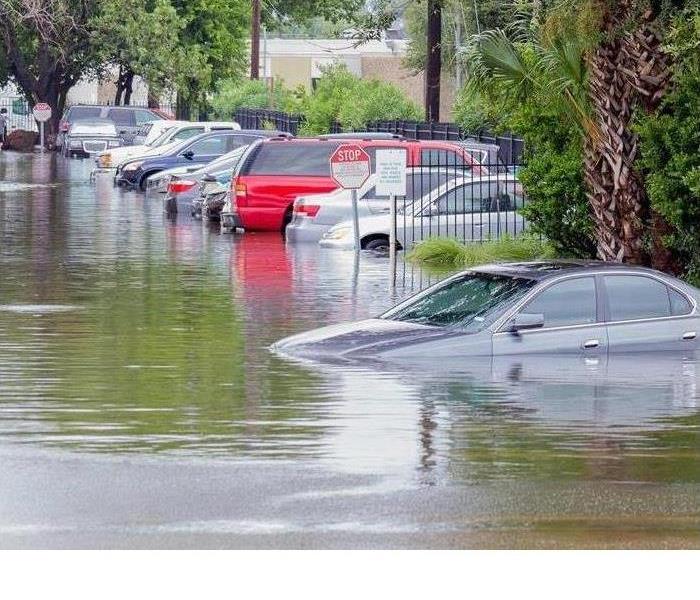 Flash flooding in Louisville, KY
Flash flooding in Louisville, KY
You are relieved that you bought flood insurance, but when there has been widespread flood damage in Kentucky, it may take a long time before the adjuster makes it to your house. You are probably getting mixed advice. Some people say it is unwise to make repairs before the adjuster comes, but others say it’s your responsibility to prevent subsequent damage. It sounds risky either way, so what should you do? You don’t want to do work that the adjuster denies, but you also have a responsibility and a need to protect your property from further damage.
Here are some initial actions you can take and why:
- Document now. Take videos and photos of all property damage to share with your flood insurance company.
- Tarp exposed areas. If there was damage to your home’s exterior, allowing wind and rain to continue entering, then you should try to prevent this exposure.
- Remove water as quickly as you can. Your flood problem can quickly become a mold problem in as little as 24 – 48 hours. Mold spores are abundant in the air, and colonies multiply rapidly.
- Move belongings out of the water. If you have larger furniture items, they can be blocked or separated from the wet floor with foil to prevent further damage. Remove smaller items from the water.
- Begin the drying process. To prevent mold damage, continue ventilating and drying your property after water is removed. If your electricity is on and safe to operate, you should use fans and air conditioning to aid this process.
These actions are all in the category of preventing additional damage, which reduces costs for everyone. What’s great about working with a reputable flood recovery company is that they likely already have established relationships with flood insurance adjusters, paving a smooth path for the claims process and for getting your home back to normal as quickly as possible.
What Happens to Your Office After Storm Damage?
6/21/2018 (Permalink)
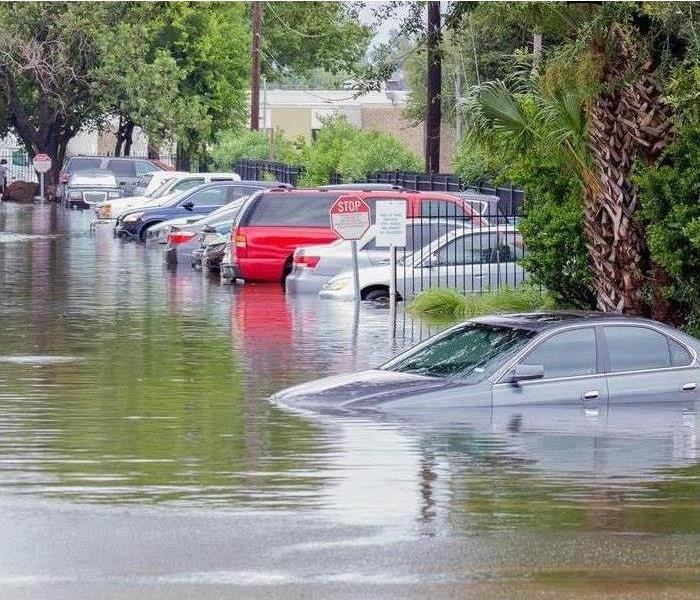 SERVPRO® of Breckinridge, Grayson, Meade & Hancock Counties 270-580-2200
SERVPRO® of Breckinridge, Grayson, Meade & Hancock Counties 270-580-2200
Flooding is one of the most damaging environmental disasters that can occur in your office building. If you’re not properly prepared, you can face significant damage and financial consequences. It’s also important that you have the assistance of an expert to tear out affected areas and thoroughly clean up the water and other damage. The Professionals will follow effective steps to ensure you can get back to regular business soon.
Inspect the damage
The storm restoration team will begin its work by looking at the extent of the issues in your building. The team will assess how much water got into your facility and whether there was any black water involved. Once the restoration professionals see the effects of the water damage, they can formulate a plan of how they’ll get your building back to a state where you can resume operations.
Get Rid of Water
The first cleanup effort will be removing water from the flood. The experts will use a proven process to do this.
• Use industrial strength water extractors.
• Dry the affected area once water is removed.
• Sanitize the area to discourage the growth of mold and other harmful materials and substances.
Remove Flooring
Once the water is gone, the restoration team will remove any severely damaged carpet, flooring, or drywall. This tear out process can be extensive depending on how large the flood was and how long the water sat in the area.
Restoration
In major flooding incidents, the team will perform restoration. This process can take several weeks and may involve rebuilding portions of your office space. Be prepared to make some adjustments to your operations because your facility, may not be in regular working order for a long period of time.
Water removal, drying, tear out and restoration are critical components of cleaning up after a flood. Make sure you call a reliable company to handle this effort.
Safety in a Storm
6/19/2018 (Permalink)
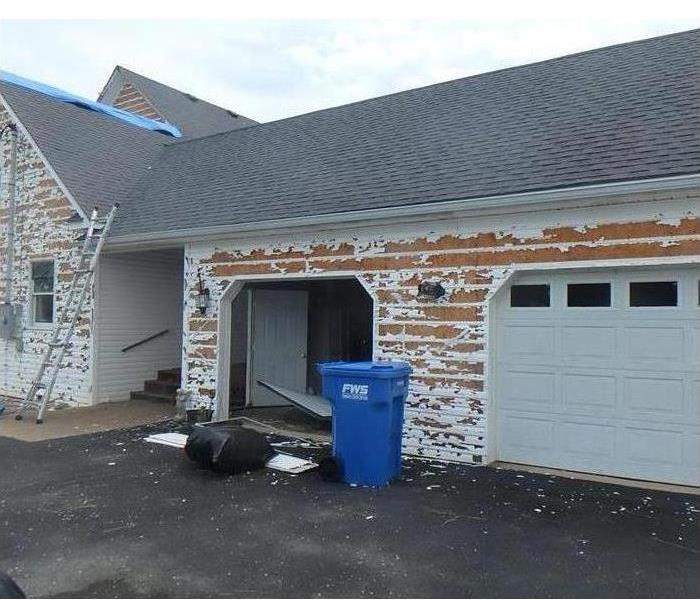 SERVPRO® of Breckinridge, Grayson, Meade & Hancock Counties. 270-580-2200
SERVPRO® of Breckinridge, Grayson, Meade & Hancock Counties. 270-580-2200
We are right in the middle of the storm season here in Kentucky. When storms are present in the local area, make sure to tune in to your local TV station or local radio. Alerts will be announced on both. If there is a warning in your area, you should go to the lowest level of your structure and get in a central location on that level. Storms can move very fast and cause tremendous damage to structures.
If you have damage from the storm... call SERVPRO of Breckinridge, Grayson, Meade & Hancock Counties. We can help with drying any wet material that you might have. We can also help with rebuilding or repairing the damage that has occurred at your home or commercial building.
What To Salvage and What To Throw Away
6/15/2018 (Permalink)
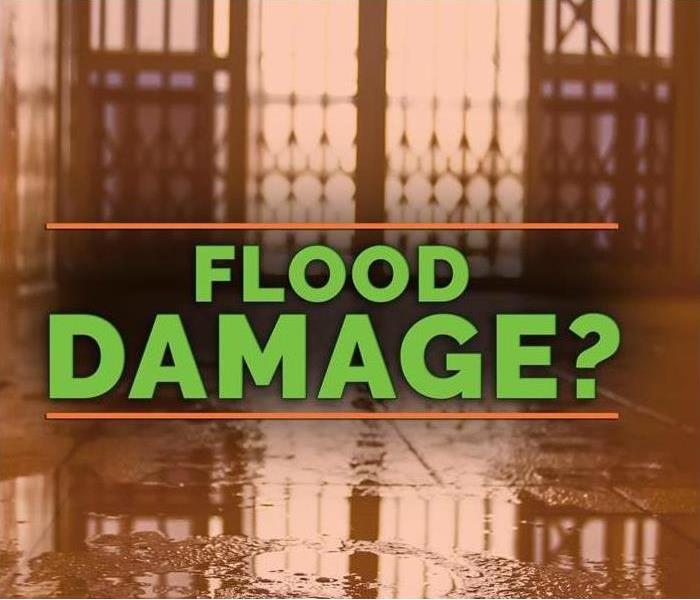 SERVPRO® of Breckinridge, Grayson, Meade & Hancock Counties. 270-580-2200
SERVPRO® of Breckinridge, Grayson, Meade & Hancock Counties. 270-580-2200
Caring for your home under normal circumstances can be stressful. When you bring flooding into the picture, it can become a downright disaster. Once your family is safe and you’ve checked with your insurance, it’s time to begin content cleaning. This is the first step to returning your home to its previous condition.
Is It Safe to Keep?
Your instinct might be to try to throw away everything that has been submerged in flood waters. This isn’t necessary, however; there are many items you may be able to safely save, clean and restore. Depending on what type of water they were exposed to, items such as drapes, clothing and other material goods might be able to be saved by washing them. This could be in your washing machine or dry cleaning, depending on the type of material. Other items that could be saved and restored include these:
• Rugs
• Furniture
• Toys
• Collectibles
Don’t Risk It; Throw It Away
Certain items should always be thrown away once exposed to flooding. Content cleaning cannot save these, especially if they were exposed to black water. Flood waters will make these unsafe for use or consumption:
• Food or beverages
• Medical supplies
• Clothing or canvas items
• Building supplies such as carpets, pads, drywall, and wood floors
Getting Help Cleaning Up
It’s best to start cleanup as soon as it’s safe for you to enter the flooded area. You want to protect yourself with gloves, masks, long pants and sleeves and rubber-soled shoes. The less exposure to contaminated water and items, the better.
One thing is for certain, when doing content cleaning after water backup or residential flooding, don’t go at it alone. Get help from friends, family, or professionals. They’ll be able to help you sort out which items are salvageable, and which are better off sent to the dumpster and replaced with new ones.
When Storms or Floods hit SERVPRO is ready!
5/21/2018 (Permalink)
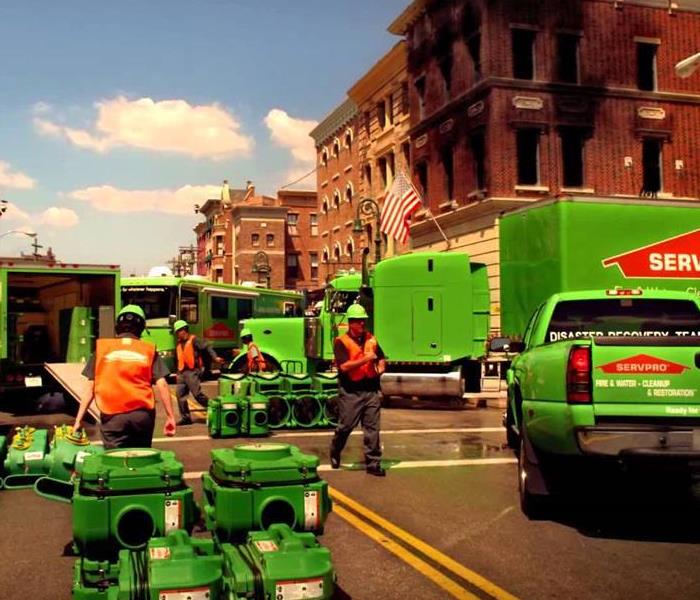 SERVPRO® of Breckinridge, Grayson, Meade & Hancock Counties. 270-580-2200
SERVPRO® of Breckinridge, Grayson, Meade & Hancock Counties. 270-580-2200
SERVPRO® of Breckinridge, Grayson, Meade & Hancock Counties specializes in storm and flood damage restoration. Our crews are highly trained, and we use specialized equipment to restore your property to its pre-storm condition.
Faster Response
Since we are locally owned and operated, we can respond quicker with the right resources, which is extremely important. A fast response lessens the damage, limits further damage, and reduces the restoration cost.
Resources to Handle Floods and Storms
When storms hit, we can scale our resources to handle a large storm or flooding disaster. We can access equipment and personnel from a network of 1,650 Franchises across the country and elite Disaster Recovery Teams that are strategically located throughout the United States.
A disaster in a home or business can be a very traumatic experience for people. We have a team of trained crew members who are experienced to help walk with you during the process and see what can be cleaned up and made like new.We love helping you make it “Like it never even happened."
Thank you for choosing SERVPRO® of Breckinridge, Grayson, Meade & Hancock Counties. Give us a call at 270-580-2200
Hitting the road to help in storm disasters
5/15/2018 (Permalink)
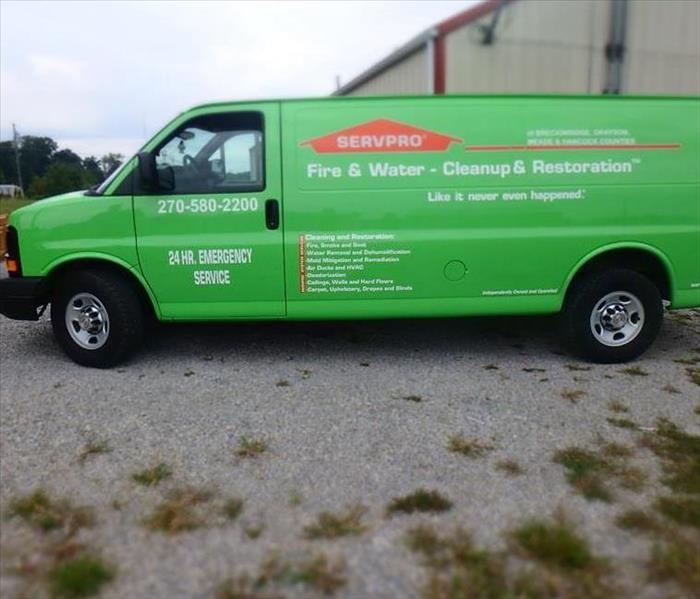 SERVPRO® of Breckinridge, Grayson, Meade & Hancock Counties 270-580-2200
SERVPRO® of Breckinridge, Grayson, Meade & Hancock Counties 270-580-2200
When a disaster strikes in an area across the nation, SERVPRO franchises unite and activate what we call, Storm. Being a corporate entity allows us to travel and help one another.
It is important to use here at SERVPRO® of Breckinridge, Grayson, Meade & Hancock Counties to "keep it green" and make sure that anyone that has storm damage is being taken care of.
We hold our staff of professionals to a high standard and expect nothing but the best for you.
When you are dealing with storm, flood, and water damage, immediate action is crucial. You should choose the company with storm damage experience and expertise that has the resources and equipment to handle the job. SERVPRO® of Breckinridge, Grayson, Meade & Hancock Counties can respond immediately to storm and flooding conditions
Torrential Rains cause flooding in Kentucky
5/15/2018 (Permalink)
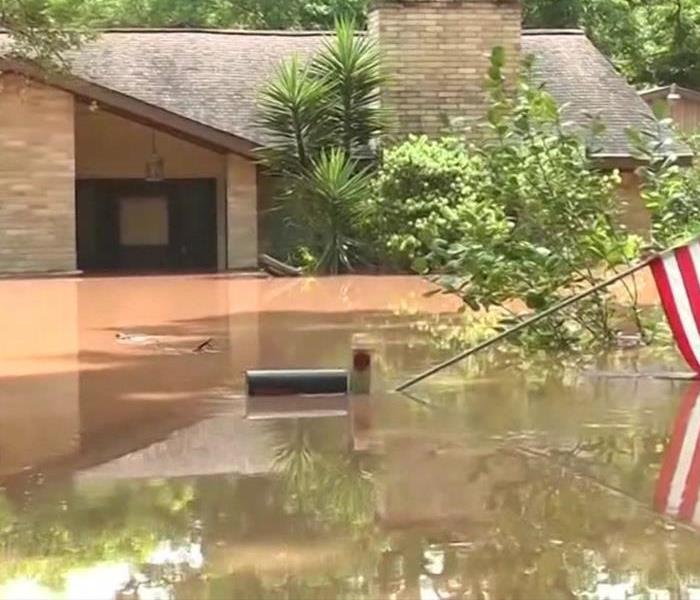 SERVPRO® of Breckinridge, Grayson, Meade & Hancock Counties. 270-580-2200
SERVPRO® of Breckinridge, Grayson, Meade & Hancock Counties. 270-580-2200
This home in Kentucky was flooded when torrential rains caused the city to overflow. SERVPRO® of Breckinridge, Grayson, Meade & Hancock Counties was at the scene to help local franchises that were inundated with jobs. There was debris scattered about and our crew was suited up in Tyvek suits, gloves, and masks to ensure their health and wellbeing was protected. The crew had to remove most of the contents from the garage and basement of this home due to the category 3 water that had saturated the items. Several hours were spent hauling out furniture and trash as well as mopping and wiping down hard surfaces. When all the mess was cleaned up, we then sprayed the area with antimicrobial to sanitize everything. The customer was very happy to have someone else take some of the burden of their loss away





 24/7 Emergency Service
24/7 Emergency Service














